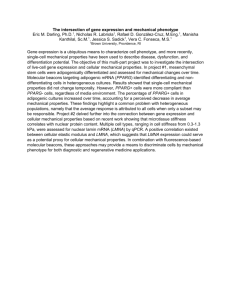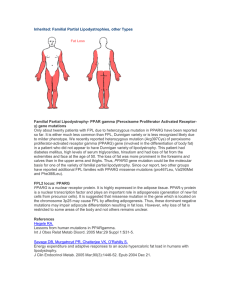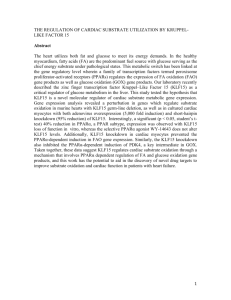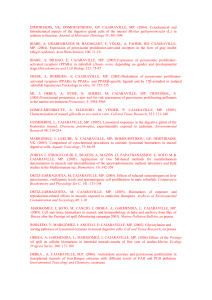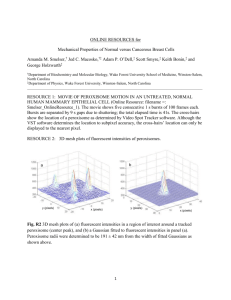trans a and PPARg by Structurally Diverse Environmental Chemicals
advertisement
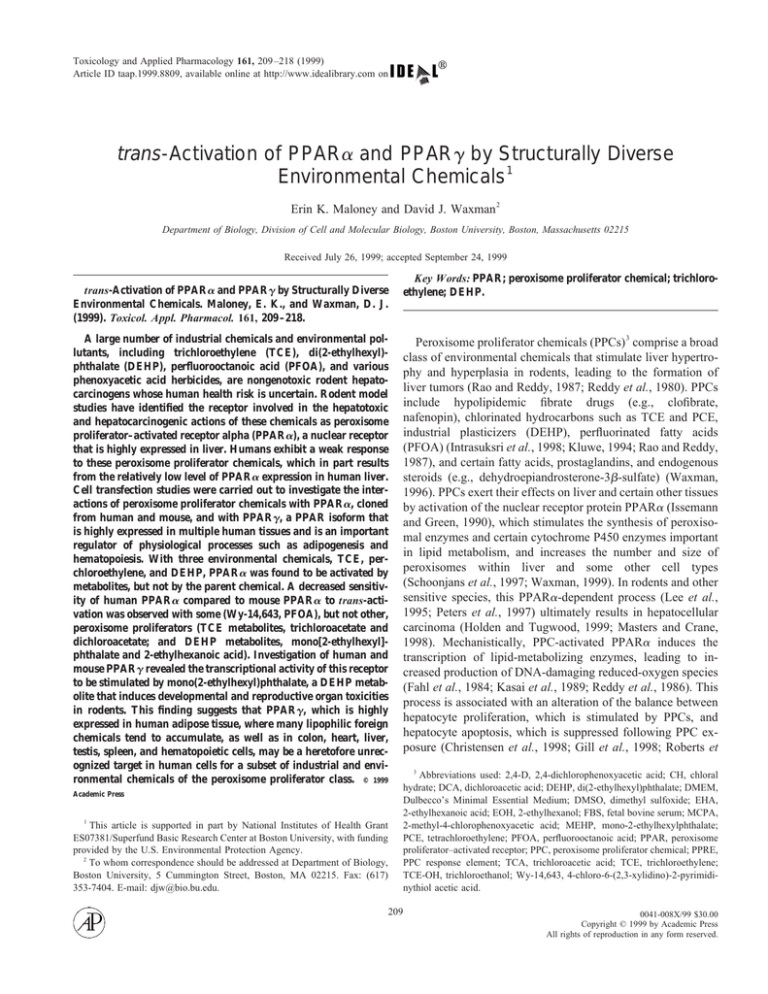
Toxicology and Applied Pharmacology 161, 209 –218 (1999) Article ID taap.1999.8809, available online at http://www.idealibrary.com on trans-Activation of PPARa and PPARg by Structurally Diverse Environmental Chemicals 1 Erin K. Maloney and David J. Waxman 2 Department of Biology, Division of Cell and Molecular Biology, Boston University, Boston, Massachusetts 02215 Received July 26, 1999; accepted September 24, 1999 Key Words: PPAR; peroxisome proliferator chemical; trichloroethylene; DEHP. trans-Activation of PPARa and PPARg by Structurally Diverse Environmental Chemicals. Maloney, E. K., and Waxman, D. J. (1999). Toxicol. Appl. Pharmacol. 161, 209 –218. A large number of industrial chemicals and environmental pollutants, including trichloroethylene (TCE), di(2-ethylhexyl)phthalate (DEHP), perfluorooctanoic acid (PFOA), and various phenoxyacetic acid herbicides, are nongenotoxic rodent hepatocarcinogens whose human health risk is uncertain. Rodent model studies have identified the receptor involved in the hepatotoxic and hepatocarcinogenic actions of these chemicals as peroxisome proliferator–activated receptor alpha (PPARa), a nuclear receptor that is highly expressed in liver. Humans exhibit a weak response to these peroxisome proliferator chemicals, which in part results from the relatively low level of PPARa expression in human liver. Cell transfection studies were carried out to investigate the interactions of peroxisome proliferator chemicals with PPARa, cloned from human and mouse, and with PPARg, a PPAR isoform that is highly expressed in multiple human tissues and is an important regulator of physiological processes such as adipogenesis and hematopoiesis. With three environmental chemicals, TCE, perchloroethylene, and DEHP, PPARa was found to be activated by metabolites, but not by the parent chemical. A decreased sensitivity of human PPARa compared to mouse PPARa to trans-activation was observed with some (Wy-14,643, PFOA), but not other, peroxisome proliferators (TCE metabolites, trichloroacetate and dichloroacetate; and DEHP metabolites, mono[2-ethylhexyl]phthalate and 2-ethylhexanoic acid). Investigation of human and mouse PPARg revealed the transcriptional activity of this receptor to be stimulated by mono(2-ethylhexyl)phthalate, a DEHP metabolite that induces developmental and reproductive organ toxicities in rodents. This finding suggests that PPARg, which is highly expressed in human adipose tissue, where many lipophilic foreign chemicals tend to accumulate, as well as in colon, heart, liver, testis, spleen, and hematopoietic cells, may be a heretofore unrecognized target in human cells for a subset of industrial and environmental chemicals of the peroxisome proliferator class. © 1999 Peroxisome proliferator chemicals (PPCs) 3 comprise a broad class of environmental chemicals that stimulate liver hypertrophy and hyperplasia in rodents, leading to the formation of liver tumors (Rao and Reddy, 1987; Reddy et al., 1980). PPCs include hypolipidemic fibrate drugs (e.g., clofibrate, nafenopin), chlorinated hydrocarbons such as TCE and PCE, industrial plasticizers (DEHP), perfluorinated fatty acids (PFOA) (Intrasuksri et al., 1998; Kluwe, 1994; Rao and Reddy, 1987), and certain fatty acids, prostaglandins, and endogenous steroids (e.g., dehydroepiandrosterone-3b-sulfate) (Waxman, 1996). PPCs exert their effects on liver and certain other tissues by activation of the nuclear receptor protein PPARa (Issemann and Green, 1990), which stimulates the synthesis of peroxisomal enzymes and certain cytochrome P450 enzymes important in lipid metabolism, and increases the number and size of peroxisomes within liver and some other cell types (Schoonjans et al., 1997; Waxman, 1999). In rodents and other sensitive species, this PPARa-dependent process (Lee et al., 1995; Peters et al., 1997) ultimately results in hepatocellular carcinoma (Holden and Tugwood, 1999; Masters and Crane, 1998). Mechanistically, PPC-activated PPARa induces the transcription of lipid-metabolizing enzymes, leading to increased production of DNA-damaging reduced-oxygen species (Fahl et al., 1984; Kasai et al., 1989; Reddy et al., 1986). This process is associated with an alteration of the balance between hepatocyte proliferation, which is stimulated by PPCs, and hepatocyte apoptosis, which is suppressed following PPC exposure (Christensen et al., 1998; Gill et al., 1998; Roberts et Academic Press 1 This article is supported in part by National Institutes of Health Grant ES07381/Superfund Basic Research Center at Boston University, with funding provided by the U.S. Environmental Protection Agency. 2 To whom correspondence should be addressed at Department of Biology, Boston University, 5 Cummington Street, Boston, MA 02215. Fax: (617) 353-7404. E-mail: djw@bio.bu.edu. 209 3 Abbreviations used: 2,4-D, 2,4-dichlorophenoxyacetic acid; CH, chloral hydrate; DCA, dichloroacetic acid; DEHP, di(2-ethylhexyl)phthalate; DMEM, Dulbecco’s Minimal Essential Medium; DMSO, dimethyl sulfoxide; EHA, 2-ethylhexanoic acid; EOH, 2-ethylhexanol; FBS, fetal bovine serum; MCPA, 2-methyl-4-chlorophenoxyacetic acid; MEHP, mono-2-ethylhexylphthalate; PCE, tetrachloroethylene; PFOA, perfluorooctanoic acid; PPAR, peroxisome proliferator–activated receptor; PPC, peroxisome proliferator chemical; PPRE, PPC response element; TCA, trichloroacetic acid; TCE, trichloroethylene; TCE-OH, trichloroethanol; Wy-14,643, 4-chloro-6-(2,3-xylidino)-2-pyrimidinythiol acetic acid. 0041-008X/99 $30.00 Copyright © 1999 by Academic Press All rights of reproduction in any form reserved. 210 MALONEY AND WAXMAN al., 1998). Liver cell apoptosis is hypothesized to be a key mechanism whereby genetically damaged cells are eliminated prior to their clonal expansion, leading to fixation of PPCinduced mutations in initiated cells (Gonzalez et al., 1998; James et al., 1998). Human cells are only weakly responsive to peroxisome proliferators (Cattley et al., 1998; Holden and Tugwood, 1999), which may in part be due to their low level of PPARa (Palmer et al., 1998; Tugwood et al., 1997) and to species differences in PPARa responsiveness, as suggested by studies of the prototypic PPC Wy-14,643 (Mukherjee et al., 1994). These species differences in receptor specificity, which are primarily mediated by the receptor’s ligand-binding domain (Keller et al., 1997), have thus far been described for only two PPCs, Wy-14,643 and the synthetic arachidonic acid analog 5,8,11,14-eicosatetraynoic acid. In contrast to PPARa, a second PPAR receptor, PPARg, is highly expressed in a number of human tissues, including adipose tissue, colon, heart, liver, testis, spleen, and hematopoietic cells (Greene et al., 1995; Vidal-Puig et al., 1997). Although PPARg is known to be activated by certain foreign chemicals, including troglitazone and other thiazolidinediones used as insulin sensitizers for treatment of type II diabetes (Lehmann et al., 1995), the potential of PPARg for interaction with PPCs or other environmental agents has not been examined. Studies on the responsiveness of PPARg to environmental peroxisome proliferators may help establish the potential of these chemicals to perturb physiological processes dependent on PPARg, such as adipogenesis and hematopoiesis (Brun et al., 1997; Tontonoz et al., 1998), and thereby help identify potential human health risks associated with exposure to these agents. Di(2-ethylhexyl)phthalate (DEHP) is an industrial plasticizer and PPC that is commonly used to coat polyvinylchloride surfaces of plastics used in medical devices (intravenous drip bags, blood storage bags, medical tubing) and food packaging, to make their surfaces both tougher and more pliable (Blass, 1992). DEHP and related plasticizers readily leach from plastic surfaces and evaporate into the environment, and are major environmental contaminants in water, food, and soil. While the pathological consequences of moderate levels of DEHP exposure in human populations are uncertain, DEHP is an established reproductive toxicant (Melnick et al., 1987; Tyl et al., 1988) and hepatocarcinogen (Huber et al., 1996) in rodents. In contrast to wild-type mice, PPARa-deficient mice fed DEHP do not develop liver tumors, indicating that PPARa is an essential mediator of this hepatocarcinogenic response (Ward et al., 1998). By contrast, the testicular and renal toxicities associated with exposure to DEHP and its metabolites (Albro et al., 1989; Richburg and Boekelheide, 1996; Rothenbacher et al., 1998) are maintained in PPARa-deficient mice (Ward et al., 1998). This indicates that PPARa is not required for DEHP toxicity in extrahepatic tissues, and suggests that a distinct receptor protein, such as PPARg, may mediate the observed testicular and kidney toxicity. PPARg has recently received much attention due to its involvement in the regulation of adipocyte differentiation and its importance in the development of obesity linked to noninsulin-dependent diabetes mellitus, which can be treated with the synthetic PPARg ligand troglitazone (Brun et al., 1997). The possibility that mammalian PPARg might be activated by foreign chemical PPCs is suggested by the finding that avian PPARg 1 can mediate PPC-induced peroxisome proliferation in the uropygial gland of the duck, whereas PPARg 2, a splice variant that is expressed in adipose tissue, is primarily responsible for the regulation of duck adipocyte differentiation (Ma et al., 1998). The present study was undertaken to assess the ability of environmental chemicals of the PPC class to transactivate PPARa and PPARg cloned from both mouse and human tissues, and to compare receptor activation between species in order to determine the extent to which there are intrinsic species-dependent differences in receptor sensitivity. The PPCs presently examined for PPARa and PPARg activation are chemicals of specific interest to Superfund clean-up efforts (Fay and Mumtaz, 1996; Johnson and DeRosa, 1997), and include TCE, PCE, and their oxidized metabolites; the plasticizer DEHP and its metabolites; the industrial chemical PFOA; and the phenoxyacetic acid herbicides 2,4-D and MCPA. MATERIALS AND METHODS Chemicals. TCE, PCE, TCA, DCA, TCE-OH, CH, EOH, MCPA, 2,4-D, and PFOA, were purchased from Aldrich Chemical Co. (Milwaukee, WI). TCA (Fisher Scientific, Pittsburgh, PA), troglitazone (Rezulin; Parke-Davis Pharmaceuticals, Ann Arbor, MI), and nafenopin (Ciba-Giegy, Basel, Switzerland) were obtained from the sources indicated. Wy-14,643, DEHP, EHA, and DMSO were purchased from Sigma Chemical Co. (St. Louis, MO). MEHP was purchased from TCI America (Portland, OR). Plasmids. The Firefly luciferase reporter plasmid pHD(x3)-Luc, which contains three copies of nts 22956 to 22919 of the rat enoyl-CoA hydratase/ 3-hydroxyacyl CoA gene PPRE cloned into pCPS-Luc (Marcus et al., 1993), was obtained from Dr. J. Capone (McMaster University, Ontario, Canada). The mouse PPARa expression plasmid pCMV-PPARa (CMV promoter) (Muerhoff et al., 1992) was provided by Dr. E. Johnson (Scripps Research Institute, La Jolla, CA) and the mouse PPARg expression plasmid pSV-Sport1-PPARg 1 (SV40 promoter) (Zhu et al., 1993) was provided by Dr. J. Reddy (Northwestern University Medical School, Chicago, IL). The human PPARa expression plasmid pSG5-PPARa (SV40 promoter) (Sher et al., 1993) was obtained from Dr. F. Gonzalez (National Cancer Institute, Bethesda, MD) and a human PPARg1 expression plasmid, pSG5-PPARg 1 (SV40 promoter) (Kliewer et al., 1997) was provided by Dr. S. Kliewer (Glaxo Wellcome Inc., Research Triangle Park, NC). The Renilla luciferase reporter plasmids pRL-CMV and pRL-TK were purchased from Promega (Madison WI). Cell culture and transient transfections. COS-1 cells (American Type Culture Collection, Rockville, MD) were passaged in 100-mm tissue culture dishes (Greiner Labortechnik, Germany) in DMEM supplemented with 10% FBS (Gibco, Grand Island, NY) and 50 U/ml penicillin/streptomycin (Gibco). Cells were cultured overnight at 37°C and then reseeded at 2000 to 4000 cells/well of a 96-well tissue culture plate (Greiner Labortechnik) in DMEM containing 10% FBS. The cells were grown for 24 h and then were transfected as described below, using FuGENE 6 transfection reagent (Boehringer–Mannheim, Germany), which gave higher transfection efficiencies and more consistent results than calcium phosphate transfection methods. ENVIRONMENTAL CHEMICAL ACTIVATION OF PPAR A mixture of plasmid DNAs to be transfected was prepared, based on the following amounts of plasmid DNA per tissue culture well: 1–3 ng PPAR expression plasmid, 50 ng pHD(x3)-Luc reporter plasmid, and either 4 ng pRL-TK or 0.25 ng pRL-CMV, used to normalize transfection efficiences between samples. Salmon sperm DNA (Stratagene Inc., La Jolla, CA) was added as a carrier DNA to give 250 ng of total DNA per well. Plasmid DNAs purified on Qiagen columns were dissolved in 13 TE buffer (10 mM Tris– EDTA, pH 8). FuGENE 6 stock reagent (30 ml) was diluted into 1 ml of DMEM (without serum) to give sufficient reagent for 100 transfections (i.e., one 96-well tissue culture plate). The diluted FuGENE 6 reagent was vortexed gently, incubated 5 min at room temperature, then added dropwise to each plasmid DNA mixture at a ratio of 10 ml diluted FuGENE 6 per ;1 ml containing 250 ng DNA. FuGENE 6-DNA mixtures were incubated for 15 min at room temperature before addition to cells (see below). FuGENE 6 was maintained at a slight excess over DNA (ratio of ;1.2 ml FuGENE 6 per mg total DNA) in all experiments. To initiate transfection, 10 ml of the final FuGENE 6-DNA mix was added directly to cells growing in 100 ml of DMEM, 10% FBS in each well of a 96-well tissue culture plate without changing the culture media. After 24 h, the media was replaced by DMEM without serum and containing the PPC chemicals to be evaluated for PPAR activation. PPCs were prepared fresh on the day of use. TCA, DCA, and EHA were directly dissolved in DMEM, while the other PPCs studied were diluted from a 1000-fold stock in DMSO, except for TCE and PCE, which were diluted from a 1000-fold stock prepared in acetone. Wy-14,643 (20 mM for mouse PPARa and 40 mM for human PPARa) or nafenopin (5 mM) were used as positive controls for activation of PPARa, and troglitazone (3 mM) was used as a positive control for PPARg 1 activation. Basal PPAR activity associated with vehicle controls is presented for each experiment (graphed as the first set of bars in each figure) and reflects receptor activation by endogenous ligands (e.g., cellular fatty acids) present in the COS-1 cells. Control experiments were carried out with each of the PPC test chemicals using COS-1 cells transfected with the pHD(x3)-Luc reporter plasmid alone in the absence of PPARa or PPARg expression plasmid. No trans-activation was observed, indicating the absence of significant endogenous PPARa or PPARg in these cells (data not shown). Following PPC treatment, cells were washed once in cold phosphate-buffered saline (pH 7.4), and then lysed by incubation at 4°C in passive cell lysis buffer for 15–30 min (Promega). Firefly and Renilla luciferase activities were measured in the cell lysate using the Dual Luciferase Activity Kit (Promega). Data analysis. Luciferase activity values were normalized for transfection efficiency using Renilla luciferase activity values obtained from the same cell extract (“relative luciferase activity”), except as noted. Firefly luciferase activities are reported as 310 –3 values. Data are presented as means 6 SD luciferase activities for n 5 3 separate determinations. Experiments were generally repeated at least three times with similar results. Statistical significance relative to vehicle controls, shown in each figure, was assessed by Student’s t test, calculated using Excel 4.0 software. RESULTS Mouse and Human PPARa are trans-Activated by Wy-14,643 with Distinct Dose Dependencies To examine the differences in the sensitivity of human and mouse PPARa to trans-activation by peroxisome proliferators, COS-1 cells transfected with human or mouse PPARa expression plasmids and a PPRE-luciferase reporter were stimulated for 24 h with the prototypical peroxisome proliferator Wy14,643, at concentrations ranging from 4 nM to 20 mM. Wy14,643 trans-activated PPARa from both species (Fig. 1). Wy-14,643 maximally stimulated human PPARa and mouse PPARa to similar extents (; five- to sixfold); however, lower 211 FIG. 1. Activation of mouse and human PPARa by Wy-14,643. COS-1 cells transfected with either mouse or human PPARa and the Firefly luciferase reporter plasmid pHD(x3)-Luc were treated for 24 h with increasing concentrations of Wy-14,643. Normalized luciferase reporter values shown are means 6 SD, n 5 6. Values of p compare vehicle-treated cells (DMSO vehicle alone) with cells treated with the PPAR activator Wy-14,643 (*p , 0.05, **p , 0.005). Fold-induction values are shown above the bar for each treatment that gave a significant increase in reporter activity. concentrations of Wy-14,643 (1 mM) were required to saturate the response of mouse PPARa compared to human PPARa ($20 mM). Thus, there are intrinsic differences in the doseresponsiveness of human and mouse PPARa to Wy-14,643, a finding that is unlikely to be affected by potential differences in the absolute protein level of the two receptors achieved in the transfected COS-1 cells (see under Discussion). In control experiments performed in COS-1 cells transfected with pHD(x3)-Luc reporter in the absence of transfected PPAR receptor, no luciferase reporter activity was stimulated by Wy-14,643, or by any of the other PPARa or PPARg 1 activators examined in this study (data not shown); thus, the responses to PPCs obtained in these studies are dependent on the transfected PPAR protein. An endogenous PPAR-like activity is present in COS-1 cells, and can be activated .20-fold by the PPAR activator 15-deoxy-d-12,14-prostaglandin J2 (Zhou and Waxman, 1999). However, this endogenous PPAR-like activity is apparently unresponsive to Wy-14,643 or to the other PPCs investigated below. Effect of TCE, PCE, and Their Metabolites on PPAR trans-Activation Studies were undertaken to determine whether the peroxisome proliferative activity of TCE and PCE (Elcombe et al., 1985; Goldsworthy and Popp, 1987) is mediated by the parent hydrocarbons or by one of their oxidative metabolites, and whether PPARa and PPARg are differentially responsive to these PPCs. COS-1 cells were transiently transfected with 212 MALONEY AND WAXMAN Activation of PPARa and PPARg by DEHP and Its Metabolites FIG. 2. Activation of PPARa and PPARg 1 by TCE, PCE, and metabolites. COS-1 cells transfected as described in Fig. 1 with PPARa or PPARg 1, mouse (m), or human (h), as indicated, were stimulated with the indicated concentrations (mM) of TCA or DCA (panels A, D); TCE, PCE, or TCE-OH (panel B); or CH (panel C), as described under Materials and Methods. Vehicle-treated cell values shown in the first pair of bars in each panel (DMEM, DMSO, or acetone) correspond to luciferase activities associated with endogenous COS-1 cell ligand(s). Normalized luciferase activities (relative activity values) are means 6 SD values for n 5 3 determinations. Wy: Wy-14,643, used as a positive control for PPARa activation (20 mM for mouse PPARa and 40 mM for human PPARa). Trog: troglitazone (3 mM), used as a positive control for PPARg 1. Data presentation is as described in Fig. 1. PPARa or PPARg 1 expression plasmid together with PPRE reporter plasmid. Cells were treated for 24 h with TCE, PCE, or with the TCE and PCE metabolites (Davidson and Beliles, 1991; Miller and Guengerich, 1983) TCA, DCA, CH, or TCEOH. Wy-14,643 was used as a positive control for PPARa activation and troglitazone was used as a positive control for PPARg 1 activation in each experiment. Mouse and human PPARa were both activated by the acidic metabolites TCA and DCA (Fig. 2A), with no difference between species in terms of receptor sensitivity or maximal responsiveness (Table 1). The other metabolites tested, CH and TCE-OH, were inactive, as were the parent compounds TCE and PCE (Figs. 2B and 2C). In contrast to PPARa, PPARg 1 displayed little or no responsiveness to TCA or DCA (Fig. 2D). TCA and DCA were toxic to the cells at $7 mM, precluding studies at higher concentrations. We next examined whether PPARa or PPARg 1 could be activated in the COS-1 cell transfection system by DEHP or its primary hydrolysis products (Albro and Lavenhar, 1989), MEHP and EOH. DEHP did not activate either PPARa or PPARg 1 when tested at concentrations up to 2 mM (Figs. 3A and 3B). By contrast, MEHP activated both mouse and human PPARa in a process that was saturated at ;20 mM for receptor from both species (three- to fourfold activation; Fig. 3C). Interestingly, MEHP also activated PPARg 1, both mouse and human, in a manner similar to PPARa (Fig. 3D). This responsiveness of PPARg 1 to MEHP contrasts to this receptor’s unresponsivness to the other PPCs examined earlier, Wy14,643, TCA, and DCA. The trans-activation of PPARg by MEHP was also seen in experiments using COS-1 cells transfected with an expression plasmid for hPPARg 2 (data not shown), a splicing variant that differs from hPPARg 1 by the presence of a 28 –amino acid extension at its NH 2-terminus (Zhu et al., 1995). EHA is an acidic oxidation product of EOH, and thus is a secondary metabolite of DEHP (Albro and Lavenhar, 1989). EHA activated PPARa, but this required somewhat higher concentrations than MEHP for maximal receptor activation (Fig. 4A). By contrast, EHA did not activate either mouse or human PPARg 1 (Fig. 4C). EOH did not activate either PPARa (Fig. 4B) or PPARg1 (Fig. 4D). Effect of PFOA on PPARa and PPARg 1 Activity The effects of the peroxisome proliferator and industrial chemical PFOA (Ikeda et al., 1985; Sohlenius et al., 1992) on PPARa and PPARg 1 trans-activation were evaluated using the COS-1 cell transfection assay. PFOA maximally activated mouse PPARa at 5–10 mM, while human PPARa required somewhat higher PFOA concentrations for maximal activation (Fig. 5A). By contrast, mouse and human PPARg 1 were unresponsive to PFOA when tested at a range of 0.5 to 40 mM (Fig. 5B). Toxicity of PFOA to the COS-1 cells precluded studies at higher concentrations. Phenoxyacetic Acid Herbicides Do Not Directly Activate PPAR To study the effects of the phenoxyacetic acid herbicides 2,4-D and MCPA on PPAR activation, COS-1 cells transfected with PPARa or PPARg 1 plus the reporter plasmid pHD(x3)Luc were treated with 2,4-D or MCPA. 2,4-D did not significantly trans-activate PPARa or PPARg 1 from either species when tested at concentrations up to 800 mM (Figs. 6A and 6C). Similarly, MCPA stimulated little or no increase (# twofold) in PPARa or PPARg 1 activity at concentrations up to 400 mM (Figs. 6B and 6D). 213 ENVIRONMENTAL CHEMICAL ACTIVATION OF PPAR TABLE 1 Activation of Mouse and Human PPARa and PPARg 1 by TCA and DCA mPPARa hPPARa mPPARg 1 Treatment a Fold-activation p , 0.05 Fold-activation p , 0.05 Fold-activation p , 0.05 Wy or Troglitazone TCA 0.1 mM 1.0 mM 5.0 mM DCA 0.1 mM 1.0 mM 5.0 mM 7.7 0.004 9.3 0.001 23.5 0.01 1.1 3.4 3.7 NS b 0.04 0.006 1.3 2.5 3.7 NS 0.003 0.001 2.0 2.8 4.5 0.04 0.01 NS 1 2.5 3.5 NS 0.02 0.008 1 1.5 3.7 NS 0.013 0.014 1.5 1.4 1.7 NS NS NS a COS-1 cells transfected with the indicated PPARs were treated for 24 h with increasing concentrations of TCA and DCA. Fold-increases in reporter gene trans-activation activity compared with control cells (DMSO treatment only) are shown. Student’s t tests were calculated to assess statistical significance ( p , 0.05). Data are based on comparisons of mean 6 SD values for n 5 3 determinations. Wy-14,643 (‘Wy’) and troglitazone were used as positive controls for PPARa and PPARg, respectively. b NS 5 not significant. DISCUSSION A COS-1 cell-based transient trans-activation assay was used to characterize the activation of mouse and human PPARs by various PPCs, including several chlorinated hydrocarbons and other environmental chemicals of specific interest to Superfund clean-up efforts. COS-1 cells are suitable for these studies because they have little or no endogenous PPARa or PPARg activity, although they exhibit a PPAR-like activity when stimulated with the prostaglandin metabolite 15-deoxyd-12,14-prostaglandin J2 (Zhou and Waxman, 1999). These studies were undertaken with the following three objectives: (1) to ascertain which PPCs directly activate PPARa vs which compounds may require further metabolism for their action; (2) to compare the responsiveness of PPARa cloned from human liver, which exhibits poor responses to PPCs, to that of the corresponding PPARa form cloned from mouse, a highly responsive species; and (3) to determine whether environmental PPCs can also activate PPARg, which is expressed at high levels in a broad range of human tissues. Activation of these receptors was monitored using the luciferase reporter gene pHD(x3)-Luc, which incorporates three tandem copies of a strong PPAR response element derived from the 59-flank of the rat hydratase/dehydrogenase promoter, and enabled us to detect reporter gene activity with high sensitivity using a luminescence assay. Potential limitations that need to be considered when interpreting the findings presented in this study include the following: (1) Activation of the luciferase reporter gene involves a series of events subsequent to the initial PPAR ligand binding event. These include receptor activation and DNA binding, recruitment of coactivators, reporter gene transcription, and translation of luciferase mRNA. Accordingly, while a good correlation between receptor binding and luciferase activity measurements is generally observed in these types of studies, caution should be used in viewing the PPAR activation data presented in this report as comparative ligand binding data per se. (2) DNA sequences flanking a core PPAR response element can have a significant effect on the level and the PPAR formspecificity of the transcriptional response (Juge-Aubry et al., 1997; Palmer et al., 1995). Accordingly, it is possible that differing results would be obtained using PPREs derived from other PPAR-activated promoters. (3) Differences in PPAR expression plasmid and in the mRNA and protein stability of the fours PPARs examined in this study (PPARa and PPARg 1 from both mouse and human) could result in different levels of each PPAR protein in the transfected COS-1 cells. Direct comparison of expression levels of the four PPARs was not possible, due to the lack of purified PPAR standards or Western blotting antibodies that are reactive with the PPARs in a species- and PPAR form-independent manner. This is not considered a significant limitation, however, because the data presented do not compare absolute receptor activities. Rather, the present studies compare the intrinsic dose-responsiveness to PPCs of each PPAR, a property that is expected to be insensitive to moderate changes in receptor protein levels. Role of Metabolism in PPAR Activation by PPCs In the case of three important environmental PPCs investigated in this study, TCE, PCE, and DEHP, PPARa was found to be activated by metabolites, but not by the parent foreign chemical. Two other environmental chemicals with peroxisome proliferative activity in vivo, the chlorinated phenoxyacetic acid herbicides 2,4-D and MCPA, were found to be inactive in the COS-1 cell-based PPAR activation assay, suggesting that metabolism may be required to activate these PPCs as well. Metabolites of 2,4-D include the glucuronide, glycine, 214 MALONEY AND WAXMAN foreign chemical PPCs (TCA, DCA, MEHP, EHA). In one earlier report, intrinsic differences between mouse and human PPARa receptor activation by Wy-14,643 were not seen (Kliewer et al., 1994); however, in another study, rat PPARa was found to be more responsive to Wy-14,643 than human PPARa (Mukherjee et al., 1994), in accord with our findings with mouse and human PPARa. This differential sensitivity of human PPARa to these PPCs cannot alone account for the greatly reduced peroxisome proliferative responses seen in human compared to rodent liver cells, and other factors, such as the much lower level of PPARa expression in human compared to rodent liver (Palmer et al., 1998; Tugwood et al., 1997), are also likely to be important. The acidic TCE metabolites TCA and DCA both activated human and mouse PPARa, but not PPARg 1, with similar dose dependencies seen for PPARa from each species. The relatively high (mM) concentrations required for PPARa activation by these compounds (cf., requirement for mM concentrations of MEHP and PFOA for receptor activation) is consistent FIG. 3. Effect of DEHP and MEHP on PPARa and PPARg 1 transcriptional activity. COS-1 cells transfected with the indicated PPARs and the reporter pHD(x3)-Luc were treated for 24 h with increasing concentrations of DEHP (mM) or MEHP (mM). Shown are normalized luciferase activites or Firefly luciferase activities, as indicated (means 6 SD, n 5 3). Nif: nafenopin (5 mM), used as a positive control for PPARa activation. Wy-14,643 and troglitazone concentrations were as specified in Fig. 2. Data presentation is as described in Figs. 1 and 2. and taurine conjugates (Griffin et al., 1997). Our finding that metabolism is required for activation of at least some PPCs highlights the potential significance of interindividual differences in PPC metabolic activity in the individual responses to PPCs. 2,4-D is a weak carcinogenic peroxisome proliferator in rodents, where it can promote renal cytotoxicity and neurosystemic defects (Mattsson et al., 1997). MCPA is a rodent peroxisome proliferator that has been associated with increased risk to non-Hodgkin lymphoma and soft-tissue sarcomas in humans (Hardell and Eriksson, 1999; Lynge, 1998). Further investigation is required to delineate the role of PPAR in the toxicities associated with human exposure to these latter PPCs. Species Differences in PPAR-Responsiveness for Some but Not All PPCs Analysis of the PPC-responsiveness of human and mouse PPARa revealed that human PPARa is less sensitive than its mouse counterpart to some (Wy-14,643, PFOA) but not other FIG. 4. Effect of DEHP metabolites, EHA and EOH, on PPARa and PPARg 1 activity. Transfection of COS-1 cells; stimulation with the indicated mM concentrations of EHA, EOH, or vehicle control (DMEM or DMSO) for 24 h; reporter gene assays; and data presentation were as described in Figs. 1 and 2. Wy-14,643 was used as a positive control for PPARa activation (20 mM for mouse and 40 mM for human receptor) and troglitazone (3 mM) as a positive control for PPARg. ENVIRONMENTAL CHEMICAL ACTIVATION OF PPAR 215 tabolite is rapidly oxidized to EHA (Albro and Lavenhar, 1989). EOH is a mild dermal, respiratory, and gastrointestinal irritant in rats and rabbits, and may be involved in the formation of liver tumors in mice (Astill et al., 1996). The secondary DEHP metabolite EHA is reported to be a more potent rodent peroxisome proliferator than EOH (Cornu et al., 1992; Keith et al., 1992), in agreement with our observation that EHA and MEHP, but not EOH, can activate PPARa. In the case of PPARg 1, however, MEHP, but not EHA or EOH, stimulated receptor activity. Both human and mouse PPARg 1 were activated by MEHP at concentrations as low as 5 mM. Our finding that MEHP and EHA can trans-activate PPARa is consistent with the finding that PPARa knock-out mice exposed to DEHP do not develop liver tumors (Ward et al., 1998). However, those same mice were susceptible to DEHP-induced testicular and renal toxicities, which are thus independent of PPARa. In this regard, the trans-activation of PPARg by MEHP characterized in the present study raises the possibility that PPARg could be responsible for some of the testicular and renal toxicities associated with DEHP exposure. Further investiga- FIG. 5. Effect of PFOA on PPARa (panel A) and PPARg 1 (panel B) activity. Transfection of COS-1 cells, stimulation with the indicated mM concentrations of PFOA for 24 h, reporter gene assays, and data presentation were as described in Figs. 1 and 2. Wy-14,643 and troglitazone positive controls were as specified in Fig. 4. with the relatively weak peroxisome proliferative activity reported for TCE and PCE in vivo (Stott, 1988). The finding that human PPARa exhibits a similar sensitivity as mouse PPARa to activation by TCA and DCA contrasts with the decreased sensitivity of the human receptor to Wy-14,643, discussed earlier. Further studies are required to determine the structural basis for the species differences that characterize PPARa with respect to some, but not other, PPCs. Activation of PPAR by DEHP and Its Metabolites The plasticizer DEHP did not activate either PPARa or PPARg 1 in our COS-1 cell transfection studies. This observation is consistent with earlier reports that metabolites of DEHP mediate the toxic actions of this plasticizer in vivo (Richburg and Boekelheide, 1996; Rothenbacher et al., 1998; Sjoberg, 1986). DEHP is hydrolyzed in the liver by nonspecific esterases to yield phthalic acid, MEHP, and EOH; this latter me- FIG. 6. Effect of the phenoxyacetic acid herbicides 2,4-D and MCPA on the activation of PPARa (panels A, B) and PPARg 1 (panels C, D). COS-1 cell transfection, stimulation using the indicated mM concentrations of 2,4-D or MCPA, reporter gene assays, and data presentation were as described in Figs. 1 and 2. Wy-14,643 and troglitazone positive controls were as specified in Fig. 4. 216 MALONEY AND WAXMAN tion, including evaluation of mice selectively deficient in PPARg expression in these tissues, could help clarify this point. In conclusion, we report that human PPARa is less responsive than mouse PPARa to some, but not all, PPCs. Thus, significant differences in responsiveness to peroxisome proliferators and industrial chemicals exist between species, as well as between the isoforms PPARa and PPARg 1. TCE, PCE, and DEHP each require metabolism to exert their PPAR-dependent effects. A similar requirement for metabolism may characterize other PPCs, including the phenoxyacetic acid herbicides 2,4-D and MCPA, which did not trans-activate mouse or human PPARs, despite their established peroxisome proliferative activity in vivo. Finally, the phthalate MEHP was shown to activate PPARg, a receptor form that is highly expressed in select extrahepatic human tissues, including adipose tissue, where lipophilic foreign chemicals tend to accumulate. This latter finding raises the distinct possibility that human PPARg might be an important, heretofore unrecognized human target of foreign chemical PPCs. Further investigation, including animal studies that directly examine the susceptibility of PPARg target genes in various tissues and species to MEHP and other PPCs, will be required to provide a full understanding of the role of this receptor in the pathophysiological and toxicological responses to PPCs. ACKNOWLEDGMENTS This research was carried out with the support of the Superfund Basic Research Program (SBRP) and the Superfund Basic Research Center at Boston University (NIEHS Grant ES07381). The authors thank Drs. J. Capone, E. Johnson, J. Reddy, F. Gonzalez, and S. Kliewer for provision of plasmid DNAs. REFERENCES Albro, P. W., Chapin, R. E., Corbett, J. T., Schroeder, J., and Phelps, J. L. (1989). Mono-2-ethylhexyl phthalate, a metabolite of di-(2-ethylhexyl) phthalate, causally linked to testicular atrophy in rats. Toxicol. Appl. Pharmacol. 100, 193–200. Albro, P. W., and Lavenhar, S. R. (1989). Metabolism of di(2-ethylhexyl)phthalate. Drug Metab. Rev. 21, 13–34. Astill, B. D., Gingell, R., Guest, D., Hellwig, J., Hodgson, J. R., Kuettler, K., Mellert, W., Murphy, S. R., Sielken, R. L., Jr., and Tyler, T. R. (1996). Oncogenicity testing of 2-ethylhexanol in Fischer 344 rats and B6C3F1 mice. Fundam. Appl. Toxicol. 31, 29 – 41. Blass, C. R. (1992). PVC as a biomedical polymer—plasticizer and stabilizer toxicity. Med. Device Technol. 3, 32– 40. Brun, R. P., Kim, J. B., Hu, E., and Spiegelman, B. M. (1997). Peroxisome proliferator-activated receptor gamma and the control of adipogenesis. Curr. Opin. Lipidol. 8, 212–218. Cattley, R. C., DeLuca, J., Elcombe, C., Fenner-Crisp, P., Lake, B. G., Marsman, D. S., Pastoor, T. A., Popp, J. A., Robinson, D. E., Schwetz, B., Tugwood, J., and Wahli, W. (1998). Do peroxisome proliferating compounds pose a hepatocarcinogenic hazard to humans? Regul. Toxicol. Pharmacol. 27, 47– 60. Christensen, J. G., Gonzales, A. J., Cattley, R. C., and Goldsworthy, T. L. (1998). Regulation of apoptosis in mouse hepatocytes and alteration of apoptosis by nongenotoxic carcinogens. Cell Growth Differ. 9, 815– 825. Cornu, M. C., Lhuguenot, J. C., Brady, A. M., Moore, R., and Elcombe, C. R. (1992). Identification of the proximate peroxisome proliferator(s) derived from di (2-ethylhexyl) adipate and species differences in response. Biochem. Pharmacol. 43, 2129 –2134. Davidson, I. W., and Beliles, R. P. (1991). Consideration of the target organ toxicity of trichloroethylene in terms of metabolite toxicity and pharmacokinetics. Drug Metab. Rev. 23, 493–599. Elcombe, C. R., Rose, M. S., and Pratt, I. S. (1985). Biochemical, histological, and ultrastructural changes in rat and mouse liver following the administration of trichloroethylene: possible relevance to species differences in hepatocarcinogenicity. Toxicol. Appl. Pharmacol. 79, 365–376. Fahl, W. E., Lalwani, N. D., Watanabe, T., Goel, S. K., and Reddy, J. K. (1984). DNA damage related to increased hydrogen peroxide generation by hypolipidemic drug-induced liver peroxisomes. Proc. Natl. Acad. Sci. USA 81, 7827–7830. Fay, R. M., and Mumtaz, M. M. (1996). Development of a priority list of chemical mixtures occurring at 1188 hazardous waste sites, using the HazDat database. Food Chem. Toxicol. 34, 1163–1165. Gill, J. H., James, N. H., Roberts, R. A., and Dive, C. (1998). The nongenotoxic hepatocarcinogen nafenopin suppresses rodent hepatocyte apoptosis induced by TGFbeta1, DNA damage and Fas. Carcinogenesis 19, 299 –304. Goldsworthy, T. L., and Popp, J. A. (1987). Chlorinated hydrocarbon-induced peroxisomal enzyme activity in relation to species and organ carcinogenicity. Toxicol. Appl. Pharmacol. 88, 225–233. Gonzalez, F. J., Peters, J. M., and Cattley, R. C. (1998). Mechanism of action of the nongenotoxic peroxisome proliferators: role of the peroxisome proliferator-activator receptor alpha. J. Natl. Cancer Inst. 90, 1702–1709. Greene, M. E., Blumberg, B., McBride, O. W., Yi, H. F., Kronquist, K., Kwan, K., Hsieh, L., Greene, G., and Nimer, S. D. (1995). Isolation of the human peroxisome proliferator activated receptor gamma cDNA: expression in hematopoietic cells and chromosomal mapping. Gene Expr. 4, 281–299. Griffin, R. J., Salemme, J., Clark, J., Myers, P., and Burka, L. T. (1997). Biliary elimination of oral 2,4-dichlorophenoxyacetic acid and its metabolites in male and female Sprague-Dawley rats, B6C3F1 mice, and Syrian hamsters. J. Toxicol. Environ. Health 51, 401– 413. Hardell, L., and Eriksson, M. (1999). A case-control study of non-Hodgkin lymphoma and exposure to pesticides. Cancer 85, 1353–1360. Holden, P. R., and Tugwood, J. D. (1999). Peroxisome proliferator-activated receptor alpha: role in rodent liver cancer and species differences. J. Mol. Endocrinol. 22, 1– 8. Huber, W. W., Grasl-Kraupp, B., and Schulte-Hermann, R. (1996). Hepatocarcinogenic potential of di(2-ethylhexyl)phthalate in rodents and its implications on human risk. Crit. Rev. Toxicol. 26, 365– 481. Ikeda, T., Aiba, K., and Fukuda, K. (1985). The induction of peroxisome proliferation in rat liver by perfluorinated fatty acids, metabolically inert derivatives of fatty acids. J. Biochem. 98, 475– 482. Intrasuksri, U., Rangwala, S. M., O’Brien, M., Noonan, D. J., and Feller, D. R. (1998). Mechanisms of peroxisome proliferation by perfluorooctanoic acid and endogenous fatty acids. Gen. Pharmacol. 31, 187–197. Issemann, I., and Green, S. (1990). Activation of a member of the steroid hormone receptor superfamily by peroxisome proliferators [see comments]. Nature 347, 645– 650. James, N. H., Gill, J. H., Brindle, R., Woodyatt, N. J., Macdonald, N., Rolfe, M., Hasmall, S. C., Tugwood, J. D., Holden, P. R., and Roberts, R. A. (1998). Peroxisome proliferator-activated receptor (PPAR) alpha-regulated growth responses and their importance to hepatocarcinogenesis. Toxicol. Lett. 102, 103, 91–96. ENVIRONMENTAL CHEMICAL ACTIVATION OF PPAR Johnson, B. L., and DeRosa, C. (1997). The toxicologic hazard of superfund hazardous-waste sites. Rev. Environ. Health 12, 235–251. Juge-Aubry, C., Pernin, A., Favez, T., Burger, A. G., Wahli, W., Meier, C. A., and Desvergne, B. (1997). DNA binding properties of peroxisome proliferator-activated receptor subtypes on various natural peroxisome proliferator response elements. Importance of the 59-flanking region. J. Biol. Chem. 272, 25252–25259. Kasai, H., Okada, Y., Nishimura, S., Rao, M. S., and Reddy, J. K. (1989). Formation of 8-hydroxydeoxyguanosine in liver DNA of rats following long-term exposure to a peroxisome proliferator. Cancer Res. 49, 2603– 2605. Keith, Y., Cornu, M. C., Canning, P. M., Foster, J., Lhuguenot, J. C., and Elcombe, C. R. (1992). Peroxisome proliferation due to di (2-ethylhexyl) adipate, 2- ethylhexanol and 2-ethylhexanoic acid. Arch. Toxicol. 66, 321– 326. Keller, H., Devchand, P. R., Perroud, M., and Wahli, W. (1997). PPAR alpha structure-function relationships derived from species- specific differences in responsiveness to hypolipidemic agents. Biol. Chem. 378, 651– 655. Kliewer, S. A., Forman, B. M., Blumberg, B., Ong, E. S., Borgmeyer, U., Mangelsdorf, D. J., Umesono, K., and Evans, R. M. (1994). Differential expression and activation of a family of murine peroxisome proliferatoractivated receptors. Proc. Natl. Acad. Sci. USA 91, 7355–7359. Kliewer, S. A., Sundseth, S. S., Jones, S. A., Brown, P. J., Wisely, G. B., Koble, C. S., Devchand, P., Wahli, W., Willson, T. M., Lenhard, J. M., and Lehmann, J. M. (1997). Fatty acids and eicosanoids regulate gene expression through direct interactions with peroxisome proliferator-activated receptors alpha and gamma. Proc. Natl. Acad. Sci. USA 94, 4318 – 4323. Kluwe, W. M. (1994). The relevance of hepatic peroxisome proliferation in rats to assessment of human carcinogenic risk for pharmaceuticals. Regul. Toxicol. Pharmacol. 20, 170 –186. Lee, S. S., Pineau, T., Drago, J., Lee, E. J., Owens, J. W., Kroetz, D. L., Fernandez-Salguero, P. M., Westphal, H., and Gonzalez, F. J. (1995). Targeted disruption of the alpha isoform of the peroxisome proliferatoractivated receptor gene in mice results in abolishment of the pleiotropic effects of peroxisome proliferators. Mol. Cell. Biol. 15, 3012–3022. Lehmann, J. M., Moore, L. B., Smith-Oliver, T. A., Wilkison, W. O., Willson, T. M., and Kliewer, S. A. (1995). An antidiabetic thiazolidinedione is a high affinity ligand for peroxisome proliferator-activated receptor gamma (PPAR gamma). J. Biol. Chem. 270, 12953–12956. Lynge, E. (1998). Cancer incidence in Danish phenoxy herbicide workers, 1947–1993. Environ. Health Perspect. 106(Suppl. 2), 683– 688. Ma, H., Tam, Q. T., and Kolattukudy, P. E. (1998). Peroxisome proliferatoractivated receptor gamma1 (PPAR-gamma1) as a major PPAR in a tissue in which estrogen induces peroxisome proliferation. FEBS Lett. 434, 394 – 400. Marcus, S. L., Miyata, K. S., Zhang, B., Subramani, S., Rachubinski, R. A., and Capone, J. P. (1993). Diverse peroxisome proliferator-activated receptors bind to the peroxisome proliferator-responsive elements of the rat hydratase/dehydrogenase and fatty acyl-CoA oxidase genes but differentially induce expression. Proc. Natl. Acad. Sci. USA 90, 5723–5727. Masters, C., and Crane, D. (1998). On the role of the peroxisome in cell differentiation and carcinogenesis. Mol. Cell. Biochem. 187, 85–97. Mattsson, J. L., Charles, J. M., Yano, B. L., Cunny, H. C., Wilson, R. D., and Bus, J. S. (1997). Single-dose and chronic dietary neurotoxicity screening studies on 2,4- dichlorophenoxyacetic acid in rats. Fundam. Appl. Toxicol. 40, 111–119. Melnick, R. L., Morrissey, R. E., and Tomaszewski, K. E. (1987). Studies by the National Toxicology Program on di(2-ethylhexyl)phthalate. Toxicol. Ind. Health 3, 99 –118. Miller, R. E., and Guengerich, F. P. (1983). Metabolism of trichloroethylene in isolated hepatocytes, microsomes, and reconstituted enzyme systems containing cytochrome P-450. Cancer Res. 43, 1145–1152. 217 Muerhoff, A. S., Griffin, K. J., and Johnson, E. F. (1992). The peroxisome proliferator-activated receptor mediates the induction of CYP4A6, a cytochrome P450 fatty acid omega-hydroxylase, by clofibric acid. J. Biol. Chem. 267, 19051–19053. Mukherjee, R., Jow, L., Noonan, D., and McDonnell, D. P. (1994). Human and rat peroxisome proliferator-activated receptors (PPARs) demonstrate similar tissue distribution but different responsiveness to PPAR activators. J. Steroid Biochem. Mol. Biol. 51, 157–166. Palmer, C. N., Hsu, M. H., Griffin, H. J., and Johnson, E. F. (1995). Novel sequence determinants in peroxisome proliferator signaling. J. Biol. Chem. 270, 16114 –16121. Palmer, C. N., Hsu, M. H., Griffin, K. J., Raucy, J. L., and Johnson, E. F. (1998). Peroxisome proliferator activated receptor-alpha expression in human liver. Mol. Pharmacol. 53, 14 –22. Peters, J. M., Cattley, R. C., and Gonzalez, F. J. (1997). Role of PPAR alpha in the mechanism of action of the nongenotoxic carcinogen and peroxisome proliferator Wy-14,643. Carcinogenesis 18, 2029 –2033. Rao, M. S., and Reddy, J. K. (1987). Peroxisome proliferation and hepatocarcinogenesis. Carcinogenesis 8, 631– 636. Reddy, J. K., Azarnoff, D. L., and Hignite, C. E. (1980). Hypolipidaemic hepatic peroxisome proliferators form a novel class of chemical carcinogens. Nature 283, 397–398. Reddy, J. K., Goel, S. K., Nemali, M. R., Carrino, J. J., Laffler, T. G., Reddy, M. K., Sperbeck, S. J., Osumi, T., Hashimoto, T., Lalwani, N. D., and Rao, M. S. (1986). Transcriptional regulation of peroxisomal fatty acyl-CoA oxidase and enoyl-CoA hydratase/3-hydroxyacyl-CoA dehydrogenase in rat liver by peroxisome proliferators. Proc. Natl. Acad. Sci. USA 83, 1747– 1751. Richburg, J. H., and Boekelheide, K. (1996). Mono-(2-ethylhexyl) phthalate rapidly alters both Sertoli cell vimentin filaments and germ cell apoptosis in young rat testes. Toxicol. Appl. Pharmacol. 137, 42–50. Roberts, R. A., James, N. H., Woodyatt, N. J., Macdonald, N., and Tugwood, J. D. (1998). Evidence for the suppression of apoptosis by the peroxisome proliferator activated receptor alpha (PPAR alpha). Carcinogenesis 19, 43– 48. Rothenbacher, K. P., Kimmel, R., Hildenbrand, S., Schmahl, F. W., and Dartsch, P. C. (1998). Nephrotoxic effects of di-(2-ethylhexyl)-phthalate (DEHP) hydrolysis products on cultured kidney epithelial cells. Hum. Exp. Toxicol. 17, 336 –342. Schoonjans, K., Martin, G., Staels, B., and Auwerx, J. (1997). Peroxisome proliferator-activated receptors, orphans with ligands and functions. Curr. Opin. Lipidol. 8, 159 –166. Sher, T., Yi, H. F., McBride, O. W., and Gonzalez, F. J. (1993). cDNA cloning, chromosomal mapping, and functional characterization of the human peroxisome proliferator activated receptor. Biochemistry 32, 5598 –5604. Sjoberg, P. (1986). Effects of di(2-ethylhexyl)phthalate and five of its metabolites on rat testis in vivo and in vitro. Acta Pharmacol. Toxicol. 58, 225–233. Sohlenius, A. K., Lundgren, B., and DePierre, J. W. (1992). Perfluorooctanoic acid has persistent effects on peroxisome proliferation and related parameters in mouse liver. J. Biochem. Toxicol. 7, 205–212. Stott, W. T. (1988). Chemically induced proliferation of peroxisomes: implications for risk assessment. Regul. Toxicol. Pharmacol. 8, 125–159. Tontonoz, P., Nagy, L., Alvarez, J. G., Thomazy, V. A., and Evans, R. M. (1998). PPARgamma promotes monocyte/macrophage differentiation and uptake of oxidized LDL. Cell 93, 241–252. Tugwood, J. D., Aldridge, T. C., Lambe, K. G., MacDonald, N., and Woodyatt, N. J. (1997). Peroxisome proliferator activated-receptor: Structures and functions. Ann. N. Y. Acad. Sci. 804, 252–265. Tyl, R. W., Price, C. J., Marr, M. C., and Kimmel, C. A. (1988). Develop- 218 MALONEY AND WAXMAN mental toxicity evaluation of dietary di(2-ethylhexyl)phthalate in Fischer 344 rats and CD-1 mice. Fundam. Appl. Toxicol. 10, 395– 412. Vidal-Puig, A. J., Considine, R. V., Jimenez-Linan, M., Werman, A., Pories, W. J., Caro, J. F., and Flier, J. S. (1997). Peroxisome proliferator-activated receptor gene expression in human tissues. Effects of obesity, weight loss, and regulation by insulin and glucocorticoids. J. Clin. Invest. 99, 2416 – 2422. Ward, J. M., Peters, J. M., Perella, C. M., and Gonzalez, F. J. (1998). Receptor and nonreceptor-mediated organ-specific toxicity of di(2- ethylhexyl)phthalate (DEHP) in peroxisome proliferator-activated receptor alpha-null mice. Toxicol. Pathol. 26, 240 –246. Waxman, D. J. (1996). Role of metabolism in the activation of dehydroepiandrosterone as a peroxisome proliferator. J. Endocrinol. 150(Suppl.), S129 –S147. Waxman, D. J. (1999). P450 gene induction by structurally diverse xenochemi- cals: central role of nuclear receptors CAR, PXR and PPAR. Arch. Biochem. Biophys. 369, 11–23. Zhou, Y. C., and Waxman, D. J. (1999). Cross-talk between janus kinasesignal transducer and activator of transcription (JAK-STAT) and peroxisome proliferator-activated receptor-alpha (PPARalpha) signaling pathways. Growth hormone inhibition of PPARalpha transcriptional activity mediated by STAT5b. J. Biol. Chem. 274, 2672–2681. Zhu, Y., Alvares, K., Huang, Q., Rao, M. S., and Reddy, J. K. (1993). Cloning of a new member of the peroxisome proliferator-activated receptor gene family from mouse liver. J. Biol. Chem. 268, 26817–26820. Zhu, Y., Qi, C., Korenberg, J. R., Chen, X. N., Noya, D., Rao, M. S., and Reddy, J. K. (1995). Structural organization of mouse peroxisome proliferator-activated receptor gamma (mPPAR gamma) gene: alternative promoter use and different splicing yield two mPPAR gamma isoforms. Proc. Natl. Acad. Sci. USA 92, 7921–7925.

